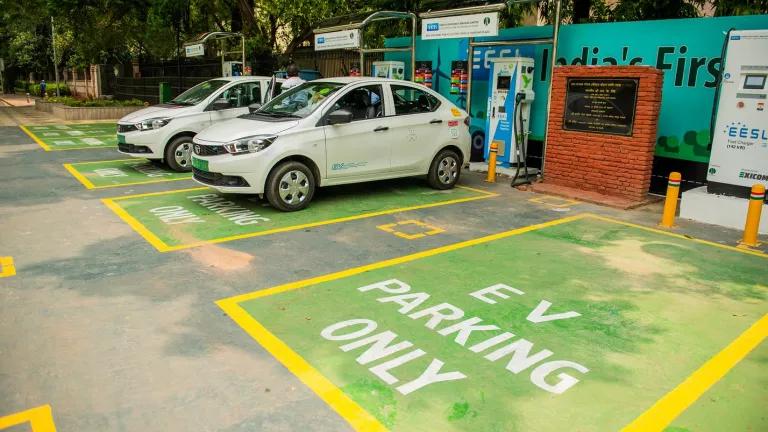
Cool roof installation in Hyderabad.
There is a tall task in front of the world leaders at the ongoing 25th session of the UN Climate Conference (COP25), in Madrid this week. The task is for all countries to commit to deeper, faster and all-encompassing cuts in the greenhouse gas emissions that are pushing our planet to a climate crisis. Cool roofs, a key solution discussed during the India Pavilion sessions at COP25 and meeting in India, are a key solution to climate change and increasing temperatures. In India, action on cool roofs is emerging as part of national policy as well as state and city policy.
At the national level, the India Cooling Action Plan (ICAP), released earlier this year aims to achieve the goals of the Kigali Amendment of the Montreal Protocol through efficiency measures and reducing demand for cooling appliances. The solutions offered by the ICAP, including cool roofs, also work to reduce the impacts of Urban Heat Islands (UHI), linked to rapid urbanization and increasing temperatures.
In India, nearly half a billion people live in fast urbanizing cities, with skyrocketing development, that converts open space into paved, heat-trapping roofs and roads. These hot surfaces worsen the heat island effect, drive temperatures higher, and lead to poor air quality, with greater energy needed to keep cool with fans and air-conditioning. Keeping it cool, is thus a priority with India’s fast and rapidly urbanizing economy and growing cooling demand. Cool roofs offer a simple and cost-effective solution to urbanization challenges. Cool roofs reflect sunlight and absorb less heat. Depending on the setting, cool roofs can help keep indoor temperatures lower by 2 to 5°C (3.6 - 9°F) as compared to traditional roofs.
Building on the success of several pilots, the state of Telangana one of the fast-growing states, with the city of Hyderabad as its capital, is ramping up efforts with expanded cool roof programs. NRDC and partners, Administrative Staff College of India (ASCI) and International Institute for Information Technology- Hyderabad (IIIT-H) are working with the state leadership to implement a state wide cool roof policy.
The city of Hyderabad hosted The Fifth International Conference on Countermeasure to Urban Heat Islands (5th IC2UHI) organized by IIIT-H last week. The conference brought together scientist, engineers and policy makers to discuss the latest research and implementation programs to help relieve the excess heat and air pollution of summers in hot cities. Cool roofs was highlighted as the central solution to counter UHIs.
Inaugurating the conference, Mr. Arvind Kumar, Principal Secretary, Municipal Administration and Urban Development Department, Government of Telangana, urged for action:
“Though development is inevitable, the challenge lies in anticipating in advance and planning ahead. Proactive actions are needed to counter urban heat islands that are being created. The state of Telangana has included mandatory energy codes & green building codes, in the new Municipal Act of the state, released in October 2019. The state is now looking to scale cool roofs implementation as an effective mitigation strategy to counter UHI”.
Principal Secretary Arvind Kumar is himself a cool roof champion with a solar reflective cool roof installed in his house in Hyderabad. He highlighted that he experienced a marked difference in the indoor room temperatures in the peak summers, after the installations.
As part of the workshop, Principal Secretary Arvind Kumar discussed the draft Telangana Cool Roofs Policy. To move the draft policy forward, NRDC and ASCI engaged with leading real estate developers to include their perspectives on draft Telangana cool roof policy. These included senior representatives from Telangana Builders Federation, Confederation of Real Estate Developers’ Associations of India (CREDAI)- Hyderabad chapter, CREDAI-Telangana, CII-Indian Green Building Council (IGBC), Architects among others.

NRDC and ASCI Team with Telangana real developers discussing the draft cool roof policy.
With over 250 commercial buildings complied with ECBC at the design stage according to the Greater Hyderabad Municipal Corporation, Telangana developers have gained confidence and experience in implementing energy efficiency codes. The developers signalled their overall support to the cool roof policy. The developers also expressed support of the proposed phase-wise implementation of the policy.
The developers also urged strengthening ecosystem support, including cool roof materials, skilled labour for installations, certifications and standards and a robust awareness and capacity building program to sensitize the tenants and the larger builder community to the cool roofs technology. A chief issue discussed was preparing a compendium of cool roof material suppliers and associated costs, and development of other knowledge materials such as a cool roof manual for easy reference by different stakeholders.
NRDC and ASCI and partners look forward to working with Telangana officials, real estate developers and key stakeholders to prepare an ecosystem of knowledge, institutional structure, human resources—in Telangana and beyond—to scale up cool roofs as both an urban heat island and climate solution.




